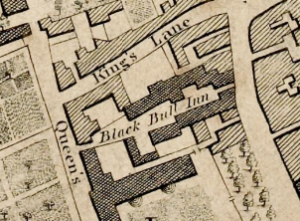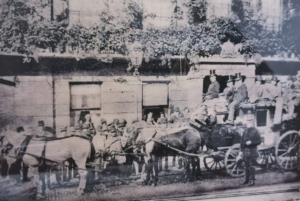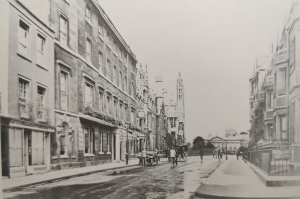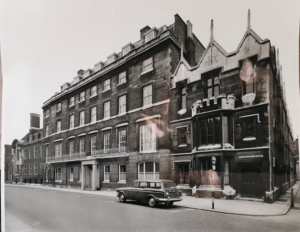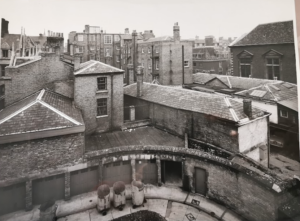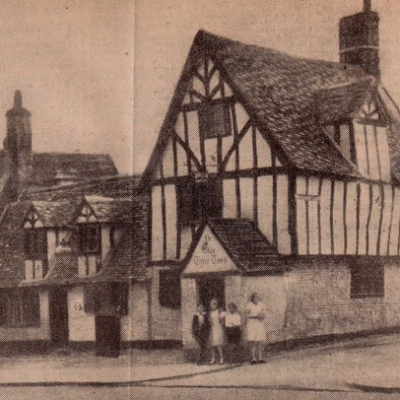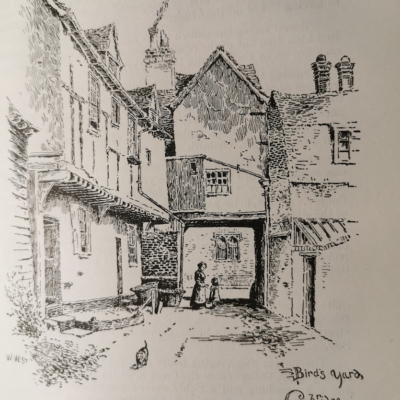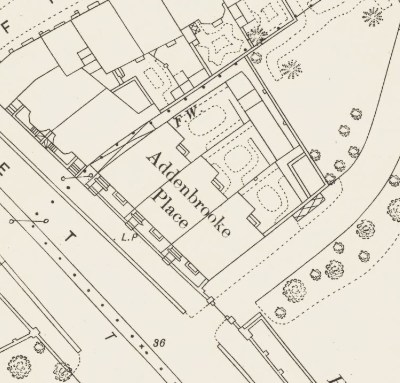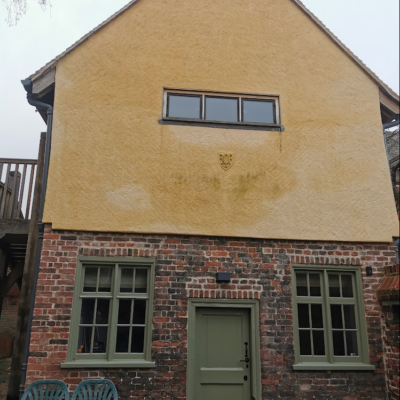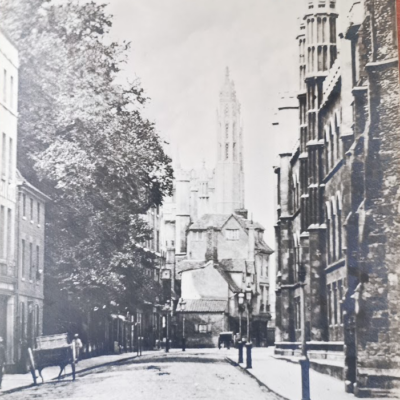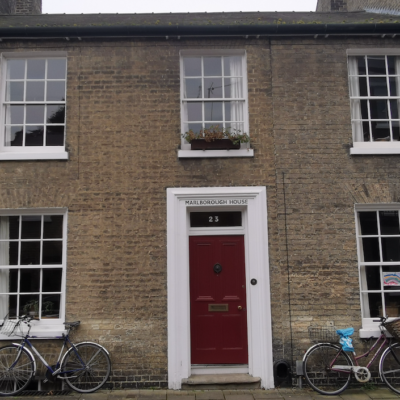Search by topic
- archaeology
- Building of Local Interest
- chapel
- charity
- church
- crime
- dressmaker
- fire
- Great Eastern Railway
- Listed building
- Mapping Relief
- medieval
- oral history
- poverty
- Public House
- Religious House
- Roman
- scholar
- school
- Then and Now
- tudor
- women
- work
- world war one
- world war two
Search by text
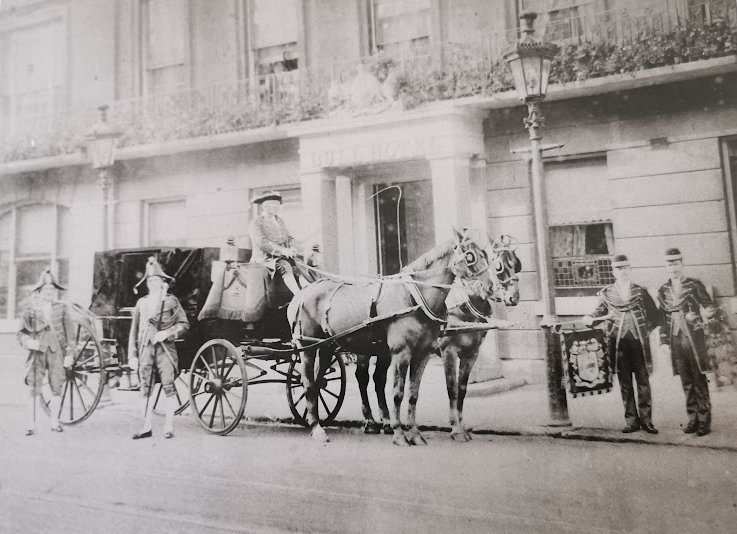 Bull Hotel, horse-drawn hansom with liveried coachmen c1880s (MoC67/45)
Bull Hotel, horse-drawn hansom with liveried coachmen c1880s (MoC67/45)64 Trumpington Street, The (Black) Bull Inn, George Inn
History of 68 Trumpington Street
In 1637 St Catharine’s acquired the property that was then the George Inn which had belonged to Thomas Hobson. A considerable area of buildings between the court of St Catharine’s and Trumpington Street was cleared. The college chapel stands on the site of the former stables where it was recorded ‘forty good cattle’ were let for hire by Hobson.
The Bull Hotel was built in 1828 but the site was the home from 1784 until 1841 of the Bull Book Club. It met weekly and had a library of 2,000. Members were limited to 50 in number.
More information can be found here:
https://en.wikipedia.org/wiki/The_Bull_Hotel,_Cambridge
The 1831 Guide to Cambridge describes it as a very superior Inn with a handsome and extended stone front. ‘On either side of the lower story are elliptically arched gateways, and in the centre a porch, composed of anti, and an entablature similar to those which adorn the Choragic Monument of Thrasylus in Athens.’
Cambridge to Oxford Coach. It was run for one year as an experiment by the seated driver Mr Carlton Bly.
Various contemporary newspaper report on the event of the suicide of the Earl De La warr in 1873. The following account is from the Australian Rockhampton Bulletin for Friday 11 July 1873:
SUICIDE OF EARL DELAWARR..
THE Earl De la Warr disappeared suddenly, and from a letter be left at his hotel it was surmised that he had committed suicide. After some search the body was found. The inquest was held at Cambridge. The first witnesses were the servants at the Bull Hotel, and a policeman who bad noticed that the deceased nobleman had his window open and was walking about his bedroom all night. Mr. Charles Harradine, of Bourn, his lordship’s agent, produced the letters found in the earl’s bedroom at the Bull, addressed to him. They were as follows: ” April 22.- Harradine, – My body will be found in the river at the nearest point from the Bull Hotel after turning up to the left from the door. DELAWARR.” ” Harradine, I have been the cause of the death of Miss Annie Nether-cote, who was living under my protection. I could not survive this; indeed, the law would not allow it, so I shall be found in the river.-DELAWARR. Send word to Haslingfield; I shall not be there.”
The letters were both much blurred and blotted. In reference to the statement contained in the second letter, important evidence was given by Dr. Charles Kirby, of No. 18, Cambridge-terrace, Hyde Park [London]. This gentleman said he knew Ann Nethercote, who lived at 41, Cambridge-street, Hyde Park [London]. He was sent in for in September last, by the Earl to see her. The witness did not know him, and asked him who he was. He said “Major-General West.” He knew the next time he went that he was Earl Delawarr. Lord Delawarr explained to him that Miss Nethercote was living under his protection. He said that she had been ill for some time, but he had great difficulty in getting her to let him send for a physician. Dr. Kirby attended her till her death, which occurred on Sunday, April 6. He saw her nearly every day. She suffered from irritation of the stomach, and died from Syncope. She was in tho constant habit of taking stimulants, and be thought it was this habit that laid the foundation of the state of her stomach. The Earl said he felt much grieved, and asked the doctor if he could do anything to prevent her indulging in this habit. She never complained of the Earl’s conduct to her in any way. The Earl seemed very much distressed after her death, although he tried to disguise it. Dr. Kirby went on to say that there was no foundation whatever for the statement in the letter that Lord Delawarr was the cause of her death. Everything possible was done for her. He saw the Earl on the Monday after her death. He seemed a good deal agitated. On the 15th he spoke to the witness about the inscription on her tomb; he was then more excited than he was before, and he did not know how to write it out He said he wanted to have put on the stone, “One loved much.” He began, and then asked the witness to wipe it. He said it would do, and sent it to the mason. Tbe deceased Earl’s coachman was subsequently called, and gave evidence tending ‘ to show that his master’s mind was seriously affected. The solicitor who appeared for the family said similar evidence could be offered, if necessary, by other servants and members of the family ; but the jury said they did not require any further evidence. The Coroner very briefly summed up ; and the jury at once returned the following verdict: ” We are unanimously of opinion that Earl Delawarr destroyed himself by drowning while suffering from temporary insanity.”
1861 Bull Hotel
John Andrew Moyes, 53, hotel keeper and farmer of 275 acres employing 13 men and 6 boys, b Kent
1871 (64)
John Moyes, hotel keeper and farmer
1881 (64)
John A Moyes, 71, hotel keeper and farmer, b Kent
John Rich, 20, fly driver, b Cambridge
In 1871 John Rich was at The Traveller’s Rest Huntingdon Road.
1891 Bull Hotel
Elizabeth A Moyes, 22, hotel keeper
Queens’ Lane: Bull Tap
John Rich, 35, ostler Bull hotel and beer??, b Cambridge
Frances, 42, b Notts
Lucy E, 12, b Cambridge
In 1901 John Rich was at 30 Bradmore Street
1910
1913 (unnumbered) The Bull Hotel
Edmund Alfred Saunders, proprietor
Miss S E Clarke, manageress
1964
Contribute
Do you have any information about the people or places in this article? If so, then please let us know using the Contact page or by emailing capturingcambridge@
License
This work is licensed under CC BY-NC-SA 4.0





